As soon as Nick Shapiro turned into the parking lot of the Tumbleweed Inn in Alexander, N.D., he recognized the trailers. They were off-white, boxy, almost cartoonish, and unadorned with any of the frills — racing stripes, awnings, window treatments — that a manufacturer would typically add to set a trailer apart on a display lot.
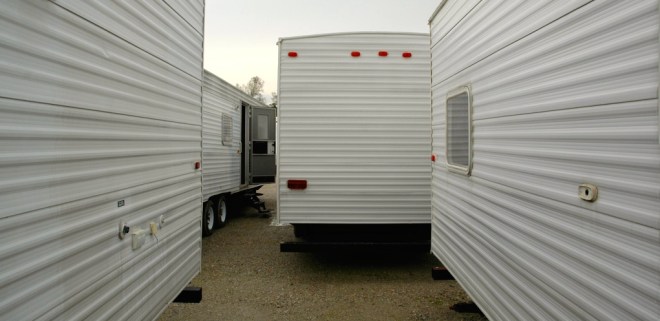
Nick Shapiro
But these trailers had never seen a display lot. Shapiro had first seen them when he was living in New Orleans in 2010, doing fieldwork for his Oxford University PhD. In New Orleans, everyone knew what they were, and the city was desperate to get rid of them. They had been built fast, and not to last. The fact that some people were still living in them because they had never gotten enough money to rebuild their homes, or had run afoul of unethical contractors, was just an unwanted reminder of how far the city still had to go to recover from Hurricane Katrina.
But in the oil fields of Alexander, where Shapiro found them, people had, at best, only a dim memory of hearing something bad about the trailers on the late night news.
Only one person in the improvised trailer park near the Tumbleweed Inn knew where the trailers were from. Now 19, he’d lived in one as a child, after his family’s home was destroyed when the levees around New Orleans broke in 2005. “It feels like home,” he said, looking around the park. “Not the landscape. The trailers. I’m used to it.”
Most of the people living in the trailer park were like him: men, young, drawn to North Dakota from all over the U.S. by the prospect of making $16-an-hour minimum in an oil boomtown. So what if they had to pay $1,200 a month to live in a trailer out on the prairie? They made it work. They slept in bunk beds, seven to a trailer, so that they could save as much as they could, and then get the hell out of there.
Get me 120,000 trailer homes, pronto!
The story of the trailers — which Grist has assembled from Freedom of Information Act requests, interviews, and the public record — goes like this: Less than 24 hours after the New Orleans levees broke, trailer companies were in touch with local officials for the Federal Emergency Management Agency (FEMA), setting up contracts to provide housing for people whose homes were destroyed in the flood. Since 80 percent of New Orleans, plus a whole lot of Louisiana, Mississippi and Alabama coastline, had been flooded, the need for housing was overwhelming. At the time, there were about 14,000 trailers in lots around the country, waiting to be sold; FEMA needed 120,000. It ordered nearly $2.7 billion worth of travel trailers and mobile homes from 60 different companies, and the production lines cranked into overdrive.
This map shows initial deployments of FEMA trailers in Louisiana between September 2005 and October 2009:[protected-iframe id=”7e44b1d5fecc9daa99cb1b1cae08d4e7-5104299-90381964″ info=”https://caldern.cartodb.com/viz/6cb98d5a-4796-11e5-8726-0e018d66dc29/embed_map” width=”100%” height=”520″ frameborder=”0″ webkitallowfullscreen=”” mozallowfullscreen=”” allowfullscreen=””]
Maps by Clayton Aldern. Video above by Mariel Carr.
Still, a month after Katrina and Rita hit landfall, Louisiana had only managed to get 109 families into trailers. The alternatives were overcrowded shelters, or squatting in the wreckage of the flood.
As new trailers arrived, they brought hope: They were shiny and new, and most importantly, had never been buried under 12 feet of water. But when the people who were supposed to live in them opened the doors, many noted a strong chemical smell inside. Some thought it was OK: It smelled kind of like a new car in there! Others did not think it was OK, especially after they started to get nosebleeds and headaches, and began to have trouble breathing. Local pediatricians began to notice an epidemic of respiratory infections in children in the area — and all of them seemed to be living in FEMA trailers.
“After the storm, about half of the people I knew were in FEMA trailers,” said Sierra Club organizer Becky Gillette. “Some of them were fine. The smokers didn’t complain much. But I had a friend who would wake up in the middle of the night, gasping for air.” Gillette knew a fair amount about air pollution — she’d worked on social justice campaigns around the local oil refinery. The link between mobile homes and formaldehyde was well documented; the low ceilings and small size concentrated any fumes emanating from the particleboard they were built with.
Even after the National Institutes of Health declared formaldehyde to be a carcinogen, the Department of Housing and Urban Development didn’t bother to regulate levels of formaldehyde for travel trailers or motor homes, under the theory that they were only temporary lodging. Formaldehyde test kits were about $35 apiece, and they added up fast. Gillette ordered 32 of them — over $1,200 worth. When 30 of the 32 tested positive for high formaldehyde levels, she shared the information with FEMA — which, she said, did nothing. So Gillette got a grant from the Sierra Club to buy even more kits.
FEMA — or at least some parts of FEMA — did know that the trailers were dangerous, though that would not emerge until the congressional hearings on the issue in 2008. FEMA appears to have stopped testing trailers in early 2006, after a field agent discovered that one trailer, which was occupied by a couple expecting their second child, had formaldehyde levels at 75 times the recommended threshold for workplace safety. The couple was relocated, and management pushed back against further testing, even after a man was found dead in his trailer a few months later. “Do not initiate any testing until we give the OK,” a FEMA lawyer named Patrick Preston advised on June 15, 2006. “Once you get results and should they indicate some problem, the clock is running on our duty to respond to them.”
That same month, the Sierra Club announced that, out of 44 trailers tested with kits purchased from Gillette’s grant, 40 had dangerously high formaldehyde levels. Mary DeVany, an occupational safety consultant who worked with the Sierra Club on interpreting the results, theorized that the plywood that was used to build some of the trailers wasn’t heat-treated properly. Trailers built by three companies in particular — Pilgrim International, Coachman Industries, and Gulf Stream Coach — had the highest levels. Kevin Broom, a spokesperson for the Recreational Vehicle Industry Association, told reporters that trailer residents needed to open their windows.
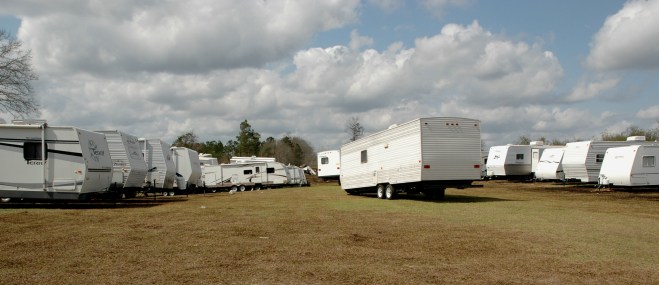
Nick Shapiro
Used trailers, warning stickers, and the free market
FEMA ultimately succeeded in deploying 140,000 trailers up and down the ravaged Gulf Coast. Then it had to start figuring out what to do with them as people began to rebuild their lives and leave them behind. The agency had planned on getting rid of the trailers by selling them, possibly even to the people who were living in them, but that was no longer an option. In July of 2007, FEMA suspended sales of the trailers to the public, and in November, it announced plans to move as many residents as possible out of the trailers — partly, a FEMA spokesperson said, because of formaldehyde levels.
Around the same time, the Centers for Disease Control and Prevention began running its own tests. It announced the results in early 2008: On average, the 519 trailers the CDC tested had five times the formaldehyde levels found in most modern homes, but a few were dramatically higher — about 40 times the recommended levels. The CDC’s then-director urged FEMA to relocate anyone still living in trailers, particularly children and the elderly, before summer, when heat would make the fumes even worse.
Even unoccupied, the trailers were costing nearly $130 million a year to store, according to federal records, but what to do with them had become a loaded question. Congressional hearings held in spring 2008 established that the trailers were unsafe. In February of 2009, the CDC started a $3.4 million pilot program designed to find people — especially children — who had lived in FEMA trailers and track the their health over time. And a massive class-action lawsuit filed by trailer residents against FEMA and the trailer manufacturers continued to work its way through the court system.
But on Jan. 1, 2010, a court injunction banning the sale of the trailers expired, and FEMA handed them off to the General Services Administration (GSA) to auction them off, for about 7 percent what FEMA had originally paid for them. The GSA made buyers sign an agreement promising not to sell them as housing, and it slapped stickers on them saying that they were not to be used for human habitation — just storage or recreation.
This map shows the locations of FEMA trailer auction buyers. Mouse over a cluster for the number of trailers purchased. Note that data are circa 2011–12, and many trailers have been resold (and relocated) since then:
[protected-iframe id=”1c5b99e2efbc51e1e29df0e0a461cc4d-5104299-90381964″ info=”https://caldern.cartodb.com/viz/9758235a-42d2-11e5-8116-0e9d821ea90d/embed_map” width=”100%” height=”520″ frameborder=”0″ webkitallowfullscreen=”” mozallowfullscreen=”” allowfullscreen=””]
Observers were aghast. “What if Toyota ordered a recall, then simply put a sticker on its vehicles saying they were unfit to drive before reselling them?” said Becky Gillette. In late 2008, FEMA had quietly sold about a thousand Katrina trailers and mobile homes as scrap; six months later, they were spotted in mobile home parks in Missouri and Georgia. What was to stop the same thing from happening over and over again — stickers or no stickers?
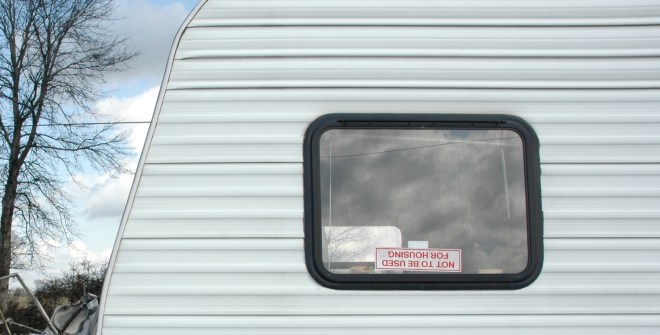
Nick Shapiro
As it turned out, nothing. FEMA trailers began to turn up everywhere, particularly in places where people needed a lot of housing fast, no questions asked. The stickers that read “NOT TO BE USED FOR HOUSING” were gone from the trailers almost as soon as they left the auction lot, though none of the buyers would admit to removing them.
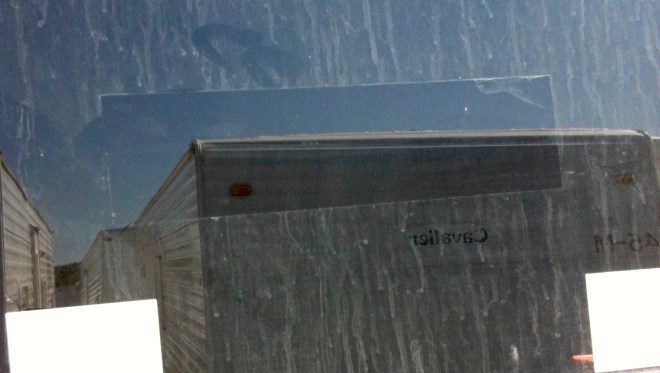
Nick Shapiro
The trailers showed up later in 2010, at the Deepwater Horizon spill. They showed up in 2011 in Alabama, Mississippi, Georgia, and Tennessee, in neighborhoods that had been flattened by tornadoes.
That was when Shapiro decided to follow up and started testing the trailers himself. He’d become preoccupied with them — how ubiquitous they remained despite their known risks. He defrayed his expenses by calling in favors; there was the analytical chemistry lab that agreed to run the tests for free, and a colleague who applied part of a grant from the National Science Foundation toward shipping.
Word got out that he was testing trailers, and people from Texas, Oklahoma, Florida, Georgia, and Illinois began to seek him out. Every test he did came in above the 16 ppm (parts per million) threshold that had been established as the new FEMA standard after the congressional hearings. None of the people who contacted Shapiro had been told, before they bought the trailers, that they were dangerous to live in. Most of them told Shapiro they couldn’t afford to move; they just appreciated knowing the risk.
Those who did try to get rid of the trailers, though, found that it wasn’t easy. Marty Horine of Clinton, Mo., bought a 32-foot ex-FEMA Gulfstream Cavalier for her son in 2007, two weeks before the trailers were officially declared unfit to live in.
Horine tried to return the trailer. The seller refused, and promptly declared bankruptcy. Horine contacted the General Services Administration, the government agency that had handled the trailer auctions. (“I’m a retired schoolteacher,” she says, dryly. “We’re a little bit of a bulldog, schoolteachers.”) But the GSA told Horine that it would only take the trailer back if she brought it to Hope, Arkansas, the site of the original auction, and it would only buy the trailer back for what the GSA had sold it for. Horine had bought hers from a reseller, for $6,000, while that reseller had bought it at auction for around $1,000.
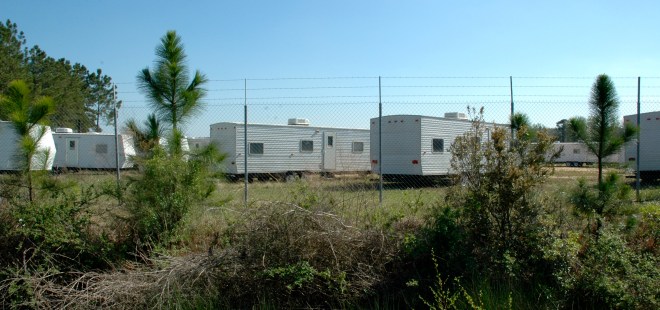
Nick Shapiro
Horine still sees FEMA trailers for sale in Clinton from time to time. Three years ago, over a hundred of them appeared for sale on a nearby lot, with the stickers scraped off. “I went over there, just acting dumb, because that’s not hard to do,” Horine drawled. “Then I said to the girl who was in charge of selling them, ‘You know this is illegal.'” The woman said that she didn’t know what Horine was talking about, but Horine noticed that the trailers were gone the next day.
Horine’s trailer remains unoccupied. She feels that selling it would be unethical. Even if she sold it on the cheap to someone who was aware of the risks, who’s to say that person wouldn’t turn around and sell it as a home to someone else? “It’s still sitting down there,” she said when I called her, as though she were describing a visitor that had overstayed its welcome.
Shapiro began to file public records requests to find out as much as he could about the trailers, and where they went. Now, when people contacted him, he had a collection of spreadsheets that he could search through to verify whether their trailer was one of the 120,000.
[protected-iframe id=”f9a4d874aff401978a9b4809c08e2cd1-5104299-15574887″ info=”https://s3.amazonaws.com/assets.grist.org/article/people-are-still-living-in-femas-toxic-katrina-trailers-and-they-likely-have-no-idea/index.html” width=”330″ height=”500″ frameborder=”0″ scrolling=”no”]
When a boomtown looks like a refugee camp
When Shapiro arrived in North Dakota, he was following a rumor: that the oil boom in the Bakken Shale had attracted the Katrina trailers from across the country like filings to a magnet. What he didn’t expect was to find the trailers surrounding the towns of the Bakken boom at Katrina-level densities. These boomtowns were hard to distinguish from refugee camps.
How the trailers had made their way to North Dakota from Louisiana was a riddle. Back in 2010, FEMA donated several hundred trailers to the local Turtle Mountain Band of Chippewa; it would not have been hard for the trailers to migrate again out of Turtle Mountain and into the oil fields. Shapiro was expecting to find oil and gas workers living in them. But instead the trailers were occupied by young men seeking their fortunes in the service economy that had sprung up around the oil and gas workers.
The oil and gas workers lived in nicer trailers, a few feet away. But the ones the service workers occupied were falling apart: Mold was blooming out of vents and improperly sealed crevices. In a sense, the trailers had been embalmed; now they were beginning to decompose.
The good news was, after four years of air-quality readings in FEMA trailers, the levels of formaldehyde were dropping. This spring, Shapiro returned to retest a trailer owned by a retired Mississippi couple that he had tested when they contacted him back in 2011. Back then the air had measured 105.6 ppb of formaldehyde – dangerously high.
In 2015, the level was down to 20 ppb — a fifth as high, but still over the 16 ppb safety threshold. What exactly did this mean? It’s hard to say, because no one has systematically studied how the toxic trailers might have actually harmed their residents. The CDC had a plan, known as KARE (aka, Katrina and Rita Exposures), to register and track the health of FEMA trailer residents, but it never moved past the pilot stage. Shapiro says he asked CDC why and received a letter saying that the decision to not proceed rested solely with FEMA.
Shapiro gave the couple a prototype “air remediation device” – a houseplant hooked up to an aquarium pump with the diaphragm reversed. In the last year, he’d been working with a research group called Public Lab on low-cost ways that people could monitor and clean the air in their own homes. For Shapiro, the project was a morale-booster in the face of the relentlessly dispiriting trailer research. But he also worried that the plant was a kind of cop-out — a form of potted surrender to the fact that not all environmental justice campaigns result in actual environmental justice.
He tested the couple’s trailer again, anyway. A month after the installation of the “remediation device,” the formaldehyde levels had fallen 40 percent, to 12 ppm. A decade after Katrina had summoned the trailers into existence, the ill-fated homes might almost be safe to live in.
Live in one of FEMA’s Katrina trailers? Here’s what you can do.
Video by Mariel Carr. Special thanks to reporter Nick Shapiro. Maps by Clayton Aldern. VIN look-up tool by Cory Simmons. Video produced by The Chemical Heritage Foundation, a library, museum, and center for scholars in Philadelphia that fosters dialogue on the role of science and technology in society. Find out more about its multimedia magazine at distillations.org.

